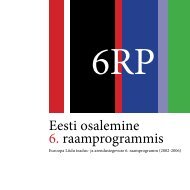Reactive Systems: Modelling, Specification and Verification - Cs.ioc.ee
Reactive Systems: Modelling, Specification and Verification - Cs.ioc.ee
Reactive Systems: Modelling, Specification and Verification - Cs.ioc.ee
You also want an ePaper? Increase the reach of your titles
YUMPU automatically turns print PDFs into web optimized ePapers that Google loves.
2.1. SOME CCS PROCESS CONSTRUCTIONS 11<br />
behaviour of an everlasting clock thus:<br />
Clock def<br />
= tick.Clock .<br />
Note that, since the process name Clock is a short-h<strong>and</strong> for the term on the righth<strong>and</strong><br />
side of the above equation, we may repeatedly replace the name Clock with<br />
its definition to obtain that<br />
Clock def<br />
= tick.Clock<br />
= tick.tick.Clock<br />
= tick.tick.tick.Clock<br />
.<br />
= tick.<br />
<br />
.<br />
<br />
. . .tick<br />
<br />
.Clock ,<br />
n-times<br />
for each positive integer n.<br />
As another recursive process specification, consider that of a simple coff<strong>ee</strong><br />
vending machine:<br />
CM def<br />
= coin.coff<strong>ee</strong>.CM . (2.1)<br />
This is a machine that is willing to accept a coin as input, deliver coff<strong>ee</strong> to its<br />
customer, <strong>and</strong> thereafter return to its initial state.<br />
Choice The CCS constructs that we have presented so far would not allow us<br />
to describe the behaviour of a vending machine that allows its paying customer<br />
to choose betw<strong>ee</strong>n tea <strong>and</strong> coff<strong>ee</strong>, say. In order to allow for the description of<br />
processes whose behaviour may follow different patterns of interaction with their<br />
environment, CCS offers the choice operator, which is written ‘+’. For example, a<br />
vending machine offering either tea or coff<strong>ee</strong> may be described thus:<br />
CTM def<br />
= coin.(coff<strong>ee</strong>.CTM + tea.CTM) . (2.2)<br />
The idea here is that, after having received a coin as input, the process CTM is willing<br />
to deliver either coff<strong>ee</strong> or tea, depending on its customer’s choice. In general,<br />
the formation rule for choice states that:<br />
If P <strong>and</strong> Q are processes, then so is P + Q.<br />
The process P +Q is one that has the initial capabilities of both P <strong>and</strong> Q. However,<br />
choosing to perform initially an action from P will pre-empt the further execution<br />
of actions from Q, <strong>and</strong> vice versa.
















